Ceramic for chewing teeth
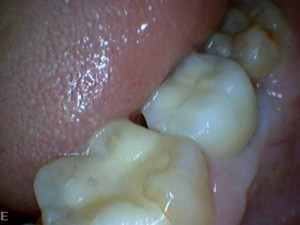
Metal-ceramic prosthetics have gained high popularity because this is the most successful compromise between aesthetics, durability and cost of structures.
Cermet is a priority for prosthetics of chewing teeth, as Here, strength plays a paramount role, and only then aesthetics.
However, this does not mean that ceramic-metal crowns on chewing teeth do not look aesthetically pleasing. They fully imitate the shades and structure of natural teeth.
In the case of front teeth, the metal base of the crowns can shine through a ceramic layer deposited on top of the metal. Therefore, for prosthetics of the front teeth, metal-free ceramics are more often used.
Advantages and disadvantages
- Cermet is a metal frame, which is a layer-by-layer application of ceramic mass. In contrast to previously produced composite materials, cermets are able to reproduce the structure of a natural tooth, without changing color when interacting with coloring materials.
- The high strength of the material allows prosthetics of both anterior and posterior teeth. Cermet for chewing teeth is preferable, while zirconia or ceramic crowns are suitable for teeth falling into the smile zone. At the same time, the high strength of metal-ceramic teeth can have a negative effect on the surface of opposing teeth and cause their increased abrasion.
- Cermet does not contain toxic substances, and therefore, is absolutely safe. However, it must be remembered that various types of cermets can behave differently in the oral cavity. If the frame of the denture contains nickel, then this can cause an allergic reaction in the patient. Some metals. The crowns that make up the frame can be oxidized by saliva.
- The disadvantages of cermets are the possibility of exposure of the metal frame of the crown when lowering the gums and the need for strong turning of the tooth tissue and depulpation.
- Dentures made of cermet have a long service life, however, even designs on gold - platinum alloy are not eternal and will last their owner more than 15 years. The warranty for cermets is 1 to 3 years, depending on the composition of the product frame.
For prosthetics of anterior teeth, structures made of zirconia or ceramic will be the most preferred option.
However, it must be borne in mind that ceramic designs are very expensive.
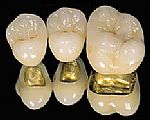
When restoring chewing teeth, cermet is quite acceptable, becausethe flaws of her aesthetics are invisible on the posterior teeth.
In addition, zirconia and cermets are not inferior in strength to each other, and aesthetics in the side section are not as important as functionality.
The most popular is cermet on a frame made of gold or its alloys with palladium or platinum due to the fact that gold is not rejected by the body, being a biocompatible material, and is not oxidized by saliva.
When using alloys on gold, crowns have a more natural tint due to the yellowness of the metal.
Video: “Cermet crowns, some features”
How to install
- When installing cermets, the patient is diagnosed.
- If necessary, the dentist treats and completes the dental canals.
- The teeth are pulped. If the condition of the supporting teeth is satisfactory, they are left alive.
- Cermets are installed on the tooth with a ledge. When grinding hard tooth tissues along its lower edge, the dentist forms a ledge to avoid contact of the metal frame of the crown and gums. This eliminates the appearance of bleeding, allergies, irritation and swelling.
Cost
The price of ceramic-metal dentures is much lower than all-ceramic. The price includes the preparation of the tooth for prosthetics (turning and depulping), the manufacture of a dental structure in the laboratory, as well as the fixation of the finished dental crown.
Depending on the status of the dental institution, the material used as the frame of the denture, the price of cermet varies within from 6,000 to 40,000 rubles.
- The cermet on the frame made of cobalt-chrome alloy of the Japanese or German manufacturer will be from 6000 rublesBelarusian or Russian - from 4500 rubles for the crown.
- A ceramic-metal crown on an alloy of gold with platinum or palladium will cost from 9,000 rubles (without the cost of gold). The total cost of the crown will be at least 18,000 rubles.
Cermets and its alternatives
- When prosthetics of distant chewing teeth, the main alternative may be solid metal crowns. In terms of reliability, they are significantly superior to cermets, much cheaper, but not quite aesthetic. However, with prosthetics of 6, 7, 8 teeth - this is not important.
- Another combined option: for example, you need to make a bridge of 5 - 7 teeth. In this case, 5 and 6 teeth fall into the line of a smile. In this case, teeth 5 and 6 should be made of cermet, and 7 - without facing. Savings in this case will be at least 2500 rubles.
Reviews
Cermet prosthetics results depend on the quality of preparation of the teeth for fixing the crowns and the absence of defects in the manufactured prosthesis. Patient reviews can be very different: both positive and negative.
- A few years ago, a ceramic-metal bridge on a cobalt-chromium alloy was installed on the lower chewing teeth. I quickly got used to my new teeth. It is convenient to chew, talk. When smiling, people around do not notice that the teeth are not real.
- My lower sixth tooth collapsed. The dentist advised to put metal ceramics, since with a smile the tooth will be noticeable. The doctor installed a pin, which was fixed with filling material. On top put on a ceramic-metal crown. At first, it was no different from my real teeth, but now it has faded and turned yellow.
- I have been walking with ceramic for chewing teeth for five years now. At first, all the teeth were the same, but about a year ago, the prostheses changed color a little. But this is not so important, since they are not visible at all during the conversation.
Photo: before and after
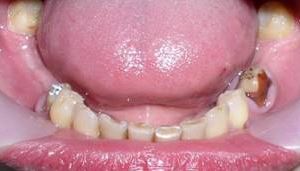 |
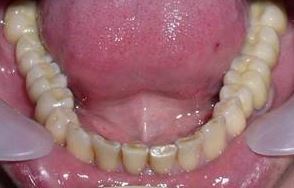 |
 |
 |
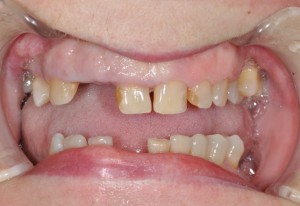 |
 |